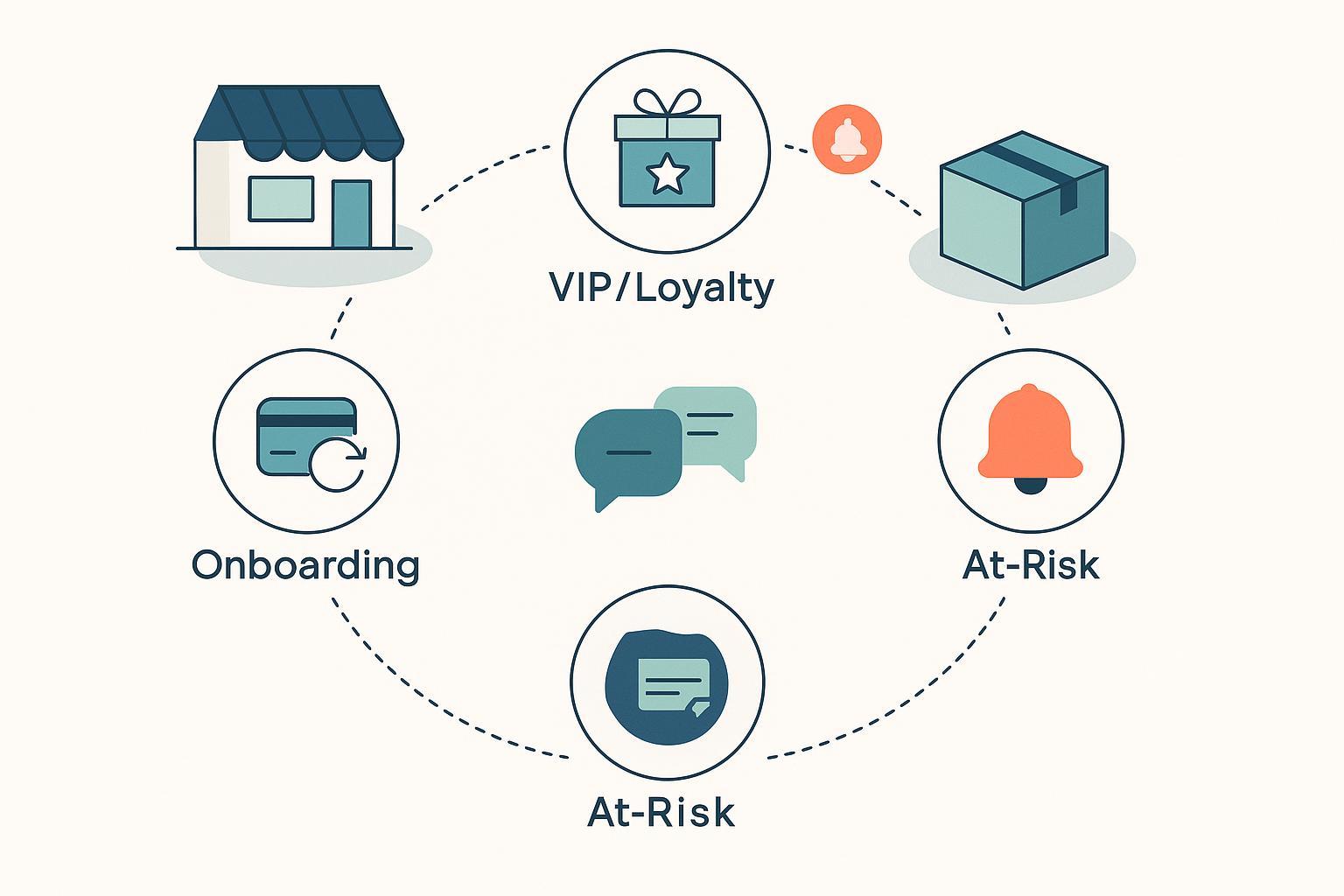Best Practices for Loyalty and Winback Campaigns in Subscription Ecommerce

If you run a subscription ecommerce brand, loyalty and winback aren’t side projects—they’re the operating system for LTV. In practice, most revenue gains come from tightening segments, triggering the right messages at the right time, and continuously measuring incremental lift. This playbook distills what works across Shopify/DTC subscriptions, grounded in data and practitioner workflows.
A unified lifecycle: from onboarding to reactivation
Subscription journeys follow predictable stages. Map your flows to these:
- Onboarding: welcome, usage education, first‑cycle check‑in
- Active: renewal reminders, product swaps, cadence adjustments
- VIP/Loyalty: milestone rewards, early access, referrals
- At‑risk: engagement drop, successive skips, discount reliance
- Churned: reactivation offers, replenishment recommendations
Why this matters: average consumer subscription churn hovers mid‑single‑digits monthly for many categories; Shopify Enterprise cites B2C churn around 6.77% in its subscriptions overview (context varies by vertical). Recoveries are real—Deloitte found churn‑and‑return stabilizing near 24% within six months in digital media (2025), signaling winbacks can recapture a meaningful share when targeted and timely.
Segmentation that actually moves retention
Effective campaigns start with precise segments. Layer these four lenses to avoid one‑size‑fits‑all messaging.
1) RFM (Recency, Frequency, Monetary)
- Signals: last purchase date, order count, total spend.
- Operationalizing: create dynamic segments—Champions/VIP, Loyal, At‑Risk, Hibernating. Attach winback flows to At‑Risk/Hibernating; create exclusives for Champions.
- Reference: RFM is widely adopted in ecommerce; see Shopify’s RFM analysis explainer for mechanics.
2) Lifecycle stage
- Signals: tenure, renewal cadence, skips/pauses, prepaid status, engagement change.
- Operationalizing: maintain stage flags (new → active → VIP → at‑risk → churned) in your CRM. Transition flows automatically on status change.
3) Behavior and intent
- Signals: browse/cart events, product usage cadence, subscription edits, survey reasons, discount reliance, customer support interactions.
- Operationalizing: use subscription app events (Ordergroove/Recharge), GA4, and CRM tracking to trigger messages that match intent (e.g., swap vs discount).
4) Predictive churn
- Signals: successive skips, declining recency, low engagement, price sensitivity markers.
- Operationalizing: apply ML‑based scores in platforms that support it (e.g., predictive churn or expected CLV). Treat high‑risk segments with preemptive save sequences rather than post‑cancellation winbacks.
Event‑based triggers you should not skip
Event timing and message relevance drive conversion. Calibrate each flow’s cadence and content.
Payment failure (involuntary churn)
- Trigger: immediate on failed charge; kick off retries via billing provider.
- Cadence: transactional email/SMS now → ML‑guided retries over 3–7 days → last reminder with support.
- Content: plain‑language reason, one‑click card update, reassurance about continuity. Limit customer‑facing touches to 3–4; rely on smart retries.
- Evidence: Recurly reported saving 72% of at‑risk subscribers via recovery events (2024), and Stripe details how Smart Retries and Authorization Boost lift recovery and auth rates.
Upcoming renewal
- Trigger: 7, 3, and 1 day pre‑renewal for physical goods; extend windows for slower consumption.
- Content: reaffirm value, usage tips, easy manage/skip links, highlight loyalty perks.
- Note: Emphasize subscriber control; see Ordergroove’s guidance on recurring models in recurring revenue models.
Skip/Pause actions
- Trigger: confirmation message immediately; follow‑up before next shipment.
- Content: propose cadence change, product swap, or smaller size; micro‑incentives where margin allows.
Inactivity/lapsed engagement
- Trigger: 14–30 days without open/click/site visit; escalate at 60/90 days.
- Content: personalized recommendations, small reactivation incentive, quick survey to capture friction.
Cancellation intent (voluntary churn)
- Trigger: cancellation page event and reason selection.
- Content: dynamic save offers tied to reason (too much product → cadence change, price → targeted discount, mismatch → swap/recommendations). Track save rates and 90‑day retention post‑save.
Stack integration that makes loyalty and winbacks work
- Ecommerce: Shopify as order/customer source of truth.
- Subscription Management: Ordergroove or Recharge for controls (skip/pause/swap), prepaid plans, and internal recovery features.
- Payments/Billing: Stripe Billing or Recurly for smart retries, dunning, card updater services.
- CRM/Automation: Klaviyo for segmentation, flows, predictive features; SMS via Attentive/Postscript.
- Analytics/Attribution: a multi‑touch layer to unify journeys and attribute loyalty/winback revenue across email/SMS/ads.
- Data/BI: GA4 and a warehouse (e.g., BigQuery) for cohort dashboards and deeper analysis.
Practical workflows you can implement this quarter
1) Winback flow (lapsed subscriber)
- Entry: 30/60/90‑day inactivity segments + subscription status.
- Sequence:
- Email: personalized recommendations based on history.
- Email: small incentive or loyalty points, social proof.
- SMS (consented): friendly reminder.
- Paid retargeting: soft‑touch audience sync (Meta/Google).
- Measurement: reactivation %, incremental revenue vs holdout, unsubscribe rate.
2) Involuntary churn recovery (payment fail)
- Entry: failed charge webhook.
- Sequence:
- Transactional email with one‑click payment update.
- ML‑guided retry window (3–7 days); optional SMS nudge.
- Final reminder with support.
- Measurement: payment recovery rate, time‑to‑recovery, revenue retained.
3) VIP loyalty engagement
- Entry: RFM “Champions” or high‑LTV segment.
- Sequence:
- Quarterly exclusives/early access.
- Milestone rewards (tenure, spend thresholds).
- Refer‑a‑friend incentives with simple sharing mechanics.
- Measurement: repeat purchase rate, LTV uplift vs non‑VIP, referral conversion.
4) Cancellation intent save
- Entry: cancellation page event + reason.
- Decisioning: dynamic offers aligned to reasons.
- Measurement: save rate, post‑save retention (90 days), CSAT.
Measurement, attribution, and A/B testing discipline
- KPIs: retention rate, churn (voluntary vs involuntary), reactivation rate, payment recovery, auth rate, cohort LTV, AOV, incremental revenue from flows, cancel‑page save rate.
- Holdouts and controls: always reserve 10–20% as control for winbacks and save offers to measure true lift.
- A/B testing: iterate subject lines, incentives (cash vs points), timing, channel mix. Use 70/30 explore/exploit once a winner emerges.
- Frequency caps: set per‑segment caps and honor preference centers to avoid fatigue.
- Attribution: use multi‑touch models to credit email/SMS/paid retargeting appropriately; track cross‑channel suppression and contribution.
Real‑world evidence: why these flows pay off
Ordergroove’s subscription brands illustrate the upside when subscriber controls and targeted messaging are dialed in: Bonafide saw +79% subscription sales over two years and 22.5% higher subscriber LTV YoY, Clarins reported +50% recurring revenue YoY, and OLLY grew subscribers +73% in 12 months with >100% subscription order growth—see the respective case pages (Bonafide, Clarins, OLLY) for details and context (years noted on those pages). Skinfix improved tracking and flows across Shopify + Ordergroove + Klaviyo, yielding a “6x increase in Klaviyo flow revenue,” according to Littledata’s Skinfix case study (case year listed on the page).
Example: unifying journeys to drive smarter loyalty and winbacks
Attribuly connects Shopify, your subscription platform, Klaviyo, and paid ad channels to unify identities and cross‑channel events so your segments and triggers reflect reality. Disclosure: Attribuly is our product.
Here’s a practical workflow we’ve used: pipe Ordergroove/Recharge status (active/paused/churned), Stripe/Recurly payment events (fail/recovered), and Klaviyo engagement into Attribuly. Build a “lapsed but engaged via ads” segment to suppress heavy winbacks when a subscriber recently visited from paid traffic; instead, sync a soft‑touch retargeting audience to Meta/Google. When a payment failure occurs, let billing handle Smart Retries; only trigger customer‑facing nudges if there’s no recovery within 48 hours. Attribute incremental revenue to the specific flow plus retargeting impressions via multi‑touch models, and review holdout lift weekly. This identity‑aware orchestration curbs fatigue, protects margins, and improves reactivation ROI.
Troubleshooting: fix common failures fast
- Over‑messaging fatigue: introduce frequency caps; pivot to retargeting or in‑app messaging for high‑fatigue segments.
- Blanket discounts eroding margin: tie incentives to cancellation reasons and RFM tiers; prefer swaps/cadence changes before discounting.
- Broken event pipes: audit server‑side events for subscription status and payment failures; backfill gaps before scaling flows.
- Ignoring involuntary churn: prioritize dunning automation; track recovery by failure type and schedule.
- No controls in testing: enforce holdouts; calculate incremental lift before rolling out.
Implementation checklist (week‑by‑week)
- Week 1: audit data flows (Shopify, subscription app, billing, CRM); define lifecycle stages; draft segments (RFM + behavior + risk).
- Week 2: stand up payment failure recovery and upcoming renewal flows; set frequency caps.
- Week 3: launch lapsed winback and cancellation intent save sequences with holdouts; add VIP rewards.
- Week 4: wire retargeting audience syncs; implement attribution dashboards; start A/B tests and weekly lift reviews.
Loyalty and winback in subscription ecommerce are won by operational excellence: accurate segmentation, event‑timed messaging, subscriber controls, and disciplined measurement. Execute the fundamentals above, and iterate with data—your LTV will follow.
